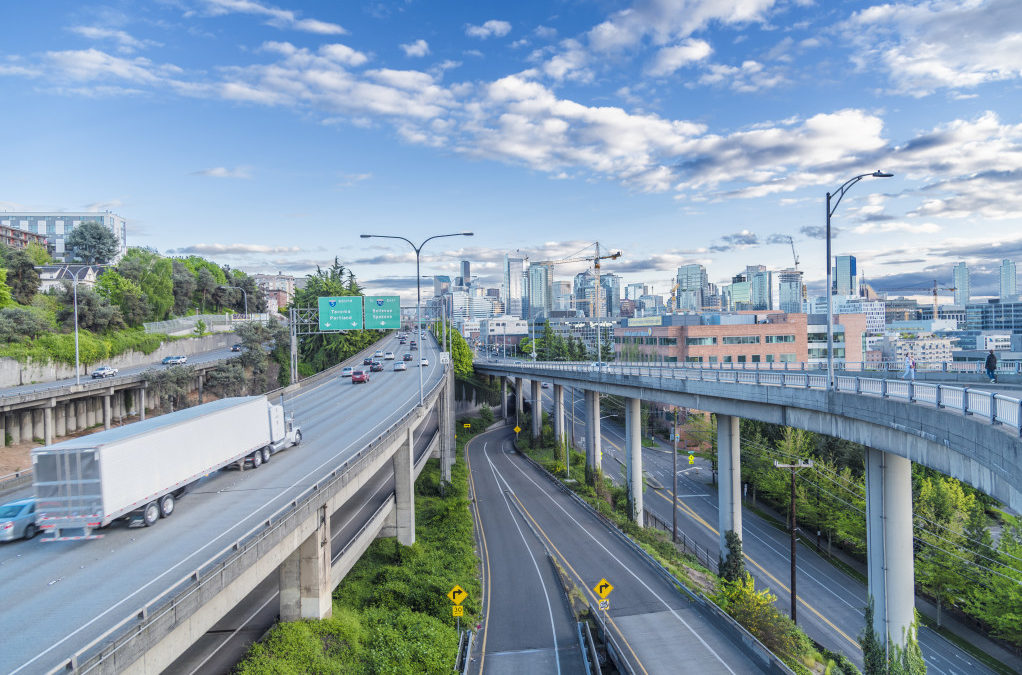Rail and trucking have been battling for years for domestic freight dominance—with the key differentials mostly coming down to price versus time. Shipping freight by rail takes longer, but usually costs less, especially with higher tonnages. When it comes to heavy and oversized loads though, deciding on your shipping mode isn’t as simple as timing and cost constraints. The size, weight, and fragility of your heavy load—and how easy it is to rig—as well as your shipment’s origin and destination are important factors to consider when making sure you choose a freight mode that’s best for your situation and your particular oversized load.
Pros and Cons of Moving Heavy Loads by Truck
Trucks haul about 80% of U.S. freight by cost and 72% of the nation’s freight by weight. The main reason being our ample, intricate, and (mostly) well-maintained interstate system. But the demand for truck shipping has reached record highs in recent years, and along with it the cost for long-haul and heavy-haul freight shipments. A few of the pros and cons to consider about transporting your heavy load by truck include:
Pros
Adaptable: Anywhere you want to ship within the United States, you can pretty much get there by truck. Contrary to popular belief, there are more miles of railway (140,000 miles) than interstate (47,000 miles) in the U.S., but when you ship by truck, you control the route and timing.
Speed: If you need to ship your heavy load in a hurry, trucks are by far the best choice, especially over short distances. This is because with a heavy or full load, you’re the truck’s only client. There are no stops for other freight passengers or layovers—it’s the equivalent of a private jet for your heavy load.
Visibility: When you transport wide loads by truck, communication tools usually show you exactly where your cargo is at all times. Rail freight companies can track cargo immaculately, but they lack the technology to communicate load positions easily.
Cons
Driver Shortage: The U.S. truck driver shortage has been estimated at 80,000 truckers or more for almost a decade. This shortage periodically causes price spikes on trucking transportation—particularly for high skilled drivers like heavy-haul truckers.
State Regulations: Every state has its own regulatory agency issuing permits for oversized loads, and shipping across state boarders requires precise scheduling and licensing.
Pros and Cons of Transporting Oversized Loads by Rail
It’s important to note that many railways simply cannot accommodate large, wide loads. Flatbed trucking might be your only option, depending on the size of your load. But some railroad companies make exceptions. In the case that your heavy load isn’t necessarily wide, rail freight comes with both benefits and challenges.
Pros
Less Expensive: Per tonnage, rail is almost always less expensive, especially if there is a surge in freight transportation demand that drives up trucking spot prices.
More Fuel Efficient: Beyond cost, if your organization has sustainability initiatives and is trying to reduce its carbon footprint, railway freight might be appealing. By some estimates, trains consume nine times less energy and are four times more fuel efficient than trucks.
Cons
Time: Because trains are almost always carrying loads by multiple shippers, they make multiple stops along their routes. Often a shipment between locations that might only take two days by truck can take two weeks by rail.
Route Limitations: Railways typically only cover transport between major cities or transportation hubs. Even then, transporting heavy loads by rail requires a flat route with no switchbacks, and tunnels—common to railroads—can make the route impassible depending on the size of your load.
Load Limitations: Flatbed rail cars are 10 feet, 8 inches wide. Anything wider than approximately 12.5 feet could collide with oncoming trains on parallel tracks or with objects like trees or even building structures that are close to the train tracks.
Covering the Last Mile in Heavy Load Transportation
The truth is, even if you ship a heavy load by train, it’s going to need truck transportation for the first and last mile, unless your destination is railway adjacent. You’ll need to rig the load onto a truck bed from its original location, then rig it onto a train bed, then off the train bed and back onto a truck bed, then off the truck at its final destination. If that sounds like a lot of work, it is.
Rigging projects are complex ventures involving multi-ton loads, lifting geometries, niche equipment and technologies, and intricate safety protocols. The more often you rig and lift your heavy equipment, the more cost you incur and the more you expose your heavy load to risk. With that in mind, shipping a heavy load by train can almost never make up on price what it would cost you in time, effort, and liability.
A Heavy Equipment Transportation Company with Rigging Expertise
Rowe Transfer has been in the transportation business for over a hundred years, and yet we keep an eye on the ever-changing dynamics of the transportation marketplace and the latest innovations in rigging. We know all the tricks it takes to successfully transport all types of heavy equipment. We specialize in moving loads that are too big or difficult for most transportation companies to handle. Whether you need a piece of heavy equipment moved across town or across the county, we have you covered. We will work with you every step of the way, from planning through execution, so you can have peace of mind that your heavy equipment will be safe and secure during the entire transportation process. If you are ready to enlist our help in shipping heavy equipment, give us a call today at 865-523-0421 or reach out to us online.

